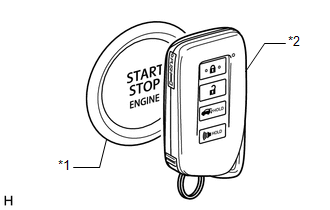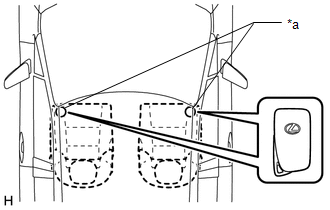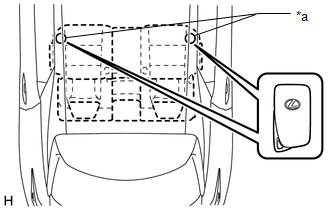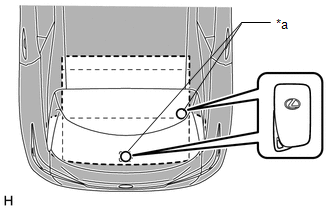Lexus RX (RX 350L, RX450h) 2016-2025 Repair Manual: Power Source Mode does not Change to ON (IG and ACC)
DESCRIPTION
If any of the following operations are performed, the certification ECU (smart key ECU assembly) receives a signal, and changes the power source mode.
- With the electrical key transmitter sub-assembly in the cabin, the engine switch is pressed.
- When the transmitter battery of the electrical key transmitter sub-assembly is depleted, the brake pedal is depressed with the electrical key transmitter sub-assembly held near the engine switch.
- When the smart access system with push-button start has been canceled, the brake pedal is depressed with the electrical key transmitter sub-assembly held near the engine switch.
| Problem Symptom | Data List and Active Test |
|---|---|
| Power source mode does not change to on (IG) or on (ACC) | Power Source Control
Starting Control
|
WIRING DIAGRAM
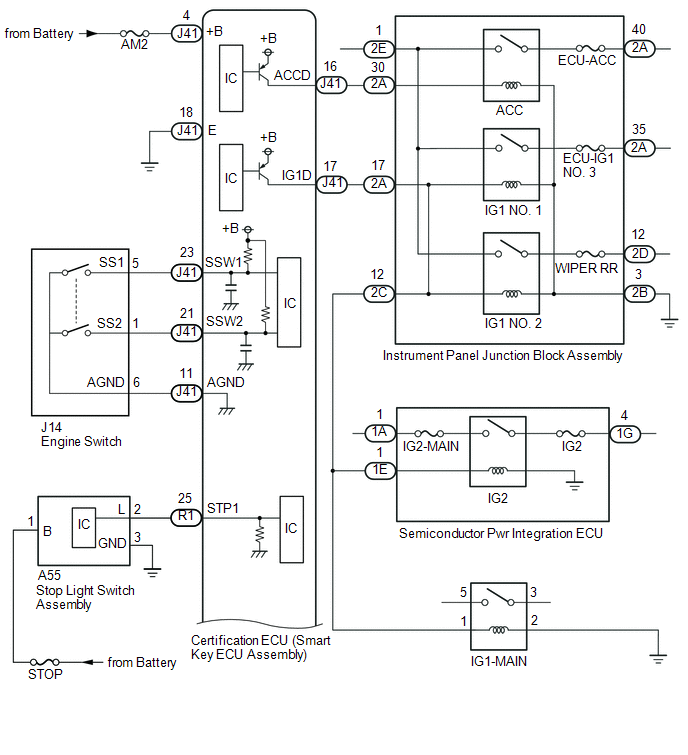
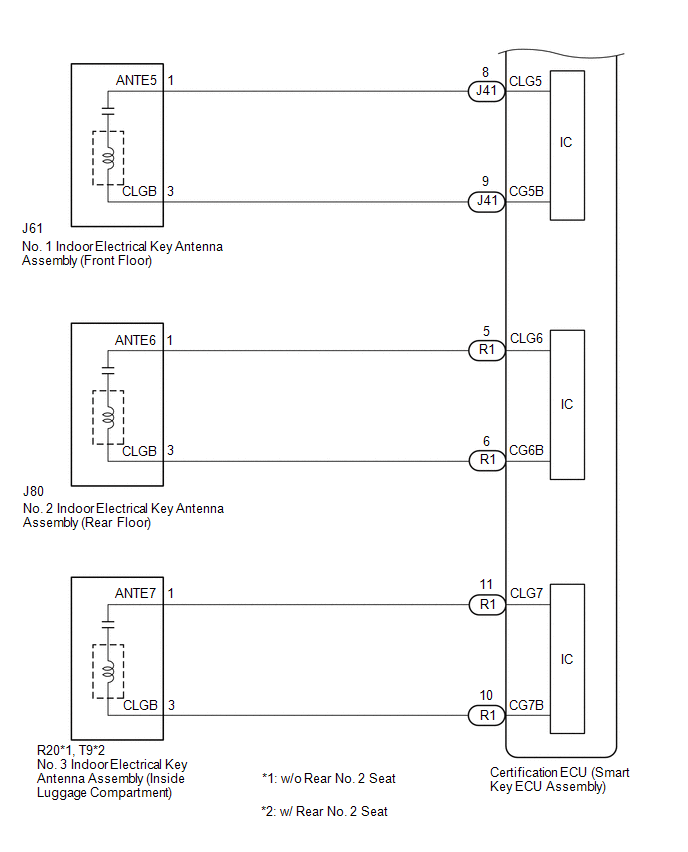
CAUTION / NOTICE / HINT
NOTICE:
- When using the Techstream with the engine switch off, connect the Techstream to the DLC3 and turn a courtesy light switch on and off at intervals of 1.5 seconds or less until communication between the Techstream and the vehicle begins. Then select the vehicle type under manual mode and enter the following menus: Body Electrical / Smart Access. While using the Techstream, periodically turn a courtesy light switch on and off at intervals of 1.5 seconds or less to maintain communication between the Techstream and the vehicle.
-
The smart access system with push-button start (for Start Function) uses the LIN communication system and CAN communication system. Inspect the communication function by following How to Proceed with Troubleshooting. Troubleshoot the smart access system with push-button start (for Start Function) after confirming that the communication systems are functioning properly.
Click here
.gif)
- Make sure that no DTCs are output. If any DTCs are output, proceed to Diagnostic Trouble Code Chart.
-
If the smart access system with push-button start (for Start Function) has been canceled, enable the system before performing troubleshooting.
Click here
.gif)
- Inspect the fuses of circuits related to this system before performing the following procedure.
-
Before replacing the certification ECU (smart key ECU assembly) or an electrical key transmitter sub-assembly, refer to smart access system with push-button start (for Start Function) Precaution.
Click here
.gif)
.gif)
- After completing repairs, confirm that the problem does not recur.
HINT:
When the cable is disconnected and reconnected to the negative (-) battery terminal, the power source mode returns to the state it was in before the cable was disconnected.
PROCEDURE
| 1. | CHECK ELECTRICAL KEY TRANSMITTER SUB-ASSEMBLY |
(a) Press a switch of the electrical key transmitter sub-assembly.
OK:
The electrical key transmitter sub-assembly LED illuminates.
| NG | .gif) | GO TO STEP 29 |
|
| 2. | READ VALUE USING TECHSTREAM (KEY LOW BATTERY) |
(a) Connect the Techstream to the DLC3.
(b) Turn the engine switch on (IG).
(c) Turn the Techstream on.
(d) Enter the following menus: Body Electrical / Smart Access / Data List.
(e) Read the Data List according to the display on the Techstream.
Body Electrical > Smart Access > Data List| Tester Display | Measurement Item | Range | Normal Condition | Diagnostic Note |
|---|---|---|---|---|
| Key Low Battery | Transmitter battery depleted | No or Yes | No: Transmitter battery not depleted Yes: Transmitter battery depleted | The electrical key transmitter sub-assembly sends voltage information to the certification ECU (smart key ECU assembly) when it is transmitting. "Yes" is displayed for the Data List item "Key Low Battery" when this voltage information indicates 2.2 V or less. This Data List item should be checked when the electrical key transmitter sub-assembly is at room temperature (example: at -20°C (-4°F), "Yes" may be displayed even if the transmitter battery is new). |
| Tester Display |
|---|
| Key Low Battery |
OK:
"No" is displayed on the Techstream screen.
| NG | .gif) | REPLACE TRANSMITTER BATTERY |
|
| 3. | CHECK ENTRY LOCK OPERATION |
(a) Check that the entry lock and unlock functions operate on each door.
Click here .gif)
.gif)
HINT:
If the door control receiver is defective, code verification does not begin in the cabin and the entry lock and unlock functions do not operate.
| Result | Proceed to |
|---|---|
| Entry functions operate normally for all doors (w/ Wireless Charging System) | A |
| Entry functions operate normally for all doors (w/o Wireless Charging System) | B |
| An entry function does not operate normally for a door | C |
| B | .gif) | GO TO STEP 5 |
| C | .gif) | GO TO OTHER PROBLEM |
|
| 4. | CHECK WIRELESS CHARGING SYSTEM |
(a) Wireless charging system off.
Click here .gif)
(b) Check that interior certification is performed.
Click here .gif)
.gif)
| Result | Proceed to |
|---|---|
| Interior certification is not performed normally | A |
| Interior certification is performed normally | B |
| B | .gif) | GO TO WIRELESS CHARGING SYSTEM |
|
| 5. | CHECK SMART ACCESS SYSTEM WITH PUSH-BUTTON START (for Start Function) |
(a) Remove the transmitter battery from the electrical key transmitter sub-assembly.
| (b) With the brake pedal depressed, hold the electrical key transmitter sub-assembly near the engine switch and check if the power source mode changes. OK: The power source mode changes. HINT: If the power source mode changes, the cabin verification is malfunctioning. |
|
| Result | Proceed to |
|---|---|
| The power source mode changes | A |
| The power source mode does not change | B |
| B | .gif) | GO TO STEP 22 |
|
| 6. | CHECK WAVE ENVIRONMENT |
(a) Install the transmitter battery to the electrical key transmitter sub-assembly.
Click here .gif)
(b) Bring the electrical key transmitter sub-assembly near the No. 1 indoor electrical key antenna assembly (front floor) and perform an smart access system with push-button start check.
Click here .gif)
.gif)
NOTICE:
Communication may not be possible if the electrical key transmitter sub-assembly is within 0.2 m (0.656 ft.) of the No. 1 indoor electrical key antenna assembly (front floor).
(c) Bring the electrical key transmitter sub-assembly near the No. 2 indoor electrical key antenna assembly (rear floor) and perform an smart access system with push-button start check.
Click here .gif)
.gif)
NOTICE:
Communication may not be possible if the electrical key transmitter sub-assembly is within 0.2 m (0.656 ft.) of the center of the No. 2 indoor electrical key antenna assembly (rear floor).
HINT:
Check that the customize setting "Ignition Available Area" is set to "All".
(d) Bring the electrical key transmitter sub-assembly near the No. 3 indoor electrical key antenna assembly (inside luggage compartment) and perform an smart access system with push-button start check.
Click here .gif)
.gif)
NOTICE:
Communication may not be possible if the electrical key transmitter sub-assembly is within 0.2 m (0.656 ft.) of the center of the No. 3 indoor electrical key antenna assembly (inside luggage compartment).
HINT:
Check that the customize setting "Ignition Available Area" is set to "All".
HINT:
- As the effect of wave interference decreases by moving the electrical key transmitter sub-assembly close to each indoor electrical key antenna assembly, it may be possible to check whether wave interference is the cause of the problem.
- If the inspection result is that the problem only occurs in certain locations or at certain times of day, the possibility of wave interference is high. Also, added vehicle components may cause wave interference. If installed, remove them and perform the operation check.
- There may be wave interference if the vehicle is near broadcasting antennas, large video displays, wireless garage door opener systems, wireless security cameras, home security systems, etc. In this case, move the vehicle to a different location and check if there is any improvement.
- If a tool for checking radio waves, such as a signal strength meter, is available, move around the area while observing both the LF band (used by the vehicle antenna to form the detection area) and RF band (used by the electrical key transmitter sub-assembly for transmission) to check for locations where there is wave interference.
OK:
The engine starts when the electrical key transmitter sub-assembly is held near each indoor electrical key antenna assembly and the engine switch is pressed with the brake pedal depressed.
| OK | .gif) | AFFECTED BY WAVE INTERFERENCE |
|
| 7. | CHECK FOR DTC (SMART ACCESS) |
(a) Check for DTCs.
Body Electrical > Smart Access > Trouble CodesOK:
DTCs are not output.
| NG | .gif) | GO TO DIAGNOSTIC TROUBLE CODE CHART |
|
| 8. | CHECK FOR DTC (POWER SOURCE CONTROL) |
(a) Check for DTCs.
Body Electrical > Power Source Control > Trouble CodesOK:
DTCs are not output.
| NG | .gif) | GO TO DIAGNOSTIC TROUBLE CODE CHART |
|
| 9. | CHECK KEY DIAGNOSTIC MODE |
(a) Check the following antennas in key diagnostic mode.
Body Electrical > Smart Access > Utility| Tester Display |
|---|
| Communication Check(Key Diag Mode) |
HINT:
- Select either channel 1 or channel 2 and perform the key diagnostic mode inspection for each channel.
- If the buzzer sounds with [CH1] displayed but not with [CH2], the electrical key transmitter sub-assembly cannot be detected by channel 2 due to a malfunction, such as wave interference.
- It is possible to check which indoor electrical key antenna assembly (front floor, rear floor or inside luggage compartment) is operating by the sounding of the buzzer.
- When the wireless buzzer sounds for all indoor electrical key antenna assemblies, they can be judged as operating properly and a malfunction in the certification ECU (smart key ECU assembly), which performs verification, is suspected.
- When the wireless buzzer does not sound for all indoor electrical key antenna assemblies, it can be judged that the certification ECU (smart key ECU assembly), which controls the indoor electrical key antenna assemblies, is malfunctioning.
| (b) Check the No. 1 indoor electrical key antenna assembly (front floor). When the electrical key transmitter sub-assembly is at either inspection point, check that the wireless buzzer sounds. |
|
| (c) Check the No. 2 indoor electrical key antenna assembly (rear floor). When the electrical key transmitter sub-assembly is at either inspection point, check that the wireless buzzer sounds. |
|
| (d) Check the No. 3 indoor electrical key antenna assembly (inside luggage compartment). When the electrical key transmitter sub-assembly is at either inspection point, check that the wireless buzzer sounds. |
|
| Result | Proceed to |
|---|---|
| The wireless buzzer does not sound for all indoor electrical key antenna assemblies | A |
| The wireless buzzer does not sound for only the No. 1 indoor electrical key antenna assembly (front floor) | B |
| The wireless buzzer does not sound for only the No. 2 indoor electrical key antenna assembly (rear floor) | C |
| The wireless buzzer does not sound for only the No. 3 indoor electrical key antenna assembly (inside luggage compartment) | D |
| The wireless buzzer sounds for all indoor electrical key antenna assemblies | E |
| A | .gif) | REPLACE CERTIFICATION ECU (SMART KEY ECU ASSEMBLY) |
| C | .gif) | GO TO STEP 13 |
| D | .gif) | GO TO STEP 16 |
| E | .gif) | GO TO STEP 19 |
|
| 10. | CHECK CERTIFICATION ECU (SMART KEY ECU ASSEMBLY) (OUTPUT TO NO. 1 INDOOR ELECTRICAL KEY ANTENNA ASSEMBLY (FRONT FLOOR)) |
(a) Using an oscilloscope, check the waveform.
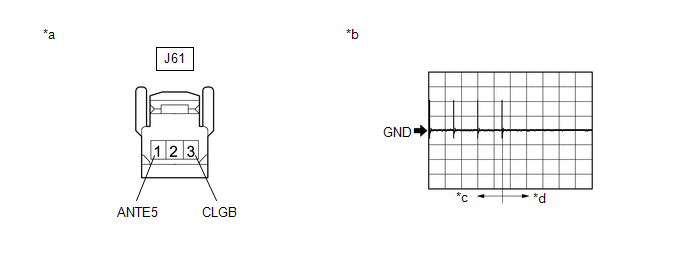
| *a | Front view of wire harness connector (to No. 1 Indoor Electrical Key Antenna Assembly (Front Floor)) | *b | Waveform 1 |
| *c | For 30 seconds after closing any door | *d | After 30 seconds or more have elapsed since any door closed |
OK:
| Tester Connection | Condition | Tool Setting | Specified Condition |
|---|---|---|---|
| J61-1 (ANTE5) - J61-3 (CLGB) | Procedure:
| 2 V/DIV., 500 ms/DIV. | Pulse generation (See waveform 1) |
| NG | .gif) | REPLACE CERTIFICATION ECU (SMART KEY ECU ASSEMBLY) |
|
| 11. | REPLACE NO. 1 INDOOR ELECTRICAL KEY ANTENNA ASSEMBLY (FRONT FLOOR) |
(a) Temporarily replace the No. 1 indoor electrical key antenna assembly (front floor) with a new one.
Click here .gif)
.gif)
|
| 12. | CHECK POWER SOURCE MODE |
(a) Get into the vehicle while carrying an electrical key transmitter sub-assembly.
(b) Move the shift lever to P.
(c) Press the engine switch with the brake pedal released and check that the power source mode changes.
| Result | Proceed to |
|---|---|
| The power source mode changes | A |
| The power source mode does not change | B |
| A | .gif) | END (NO. 1 INDOOR ELECTRICAL KEY ANTENNA ASSEMBLY (FRONT FLOOR) WAS DEFECTIVE) |
| B | .gif) | REPLACE CERTIFICATION ECU (SMART KEY ECU ASSEMBLY) |
| 13. | CHECK CERTIFICATION ECU (SMART KEY ECU ASSEMBLY) (OUTPUT TO NO. 2 INDOOR ELECTRICAL KEY ANTENNA ASSEMBLY (REAR FLOOR)) |
(a) Using an oscilloscope, check the waveform.
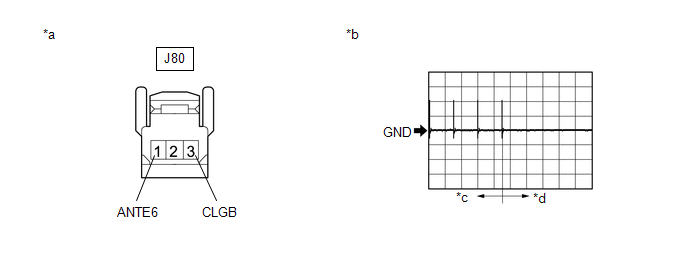
| *a | Front view of wire harness connector (to No. 2 Indoor Electrical Key Antenna Assembly (Rear Floor)) | *b | Waveform 1 |
| *c | For 30 seconds after closing any door | *d | After 30 seconds or more have elapsed since any door closed |
OK:
| Tester Connection | Condition | Tool Setting | Specified Condition |
|---|---|---|---|
| J80-1 (ANTE6) - J80-3 (CLGB) | Procedure:
| 2 V/DIV., 500 ms/DIV. | Pulse generation (See waveform 1) |
| NG | .gif) | REPLACE CERTIFICATION ECU (SMART KEY ECU ASSEMBLY) |
|
| 14. | REPLACE NO. 2 INDOOR ELECTRICAL KEY ANTENNA ASSEMBLY (REAR FLOOR) |
(a) Temporarily replace the No. 2 indoor electrical key antenna assembly (rear floor) with a new one.
Click here .gif)
.gif)
|
| 15. | CHECK POWER SOURCE MODE |
(a) Get into the vehicle while carrying an electrical key transmitter sub-assembly.
(b) Move the shift lever to P.
(c) Press the engine switch with the brake pedal released and check that the power source mode changes.
| Result | Proceed to |
|---|---|
| The power source mode changes | A |
| The power source mode does not change | B |
| A | .gif) | END (NO. 2 INDOOR ELECTRICAL KEY ANTENNA ASSEMBLY (REAR FLOOR) WAS DEFECTIVE) |
| B | .gif) | REPLACE CERTIFICATION ECU (SMART KEY ECU ASSEMBLY) |
| 16. | CHECK CERTIFICATION ECU (SMART KEY ECU ASSEMBLY) (OUTPUT TO NO. 3 INDOOR ELECTRICAL KEY ANTENNA ASSEMBLY (INSIDE LUGGAGE COMPARTMENT)) |
(a) Using an oscilloscope, check the waveform.
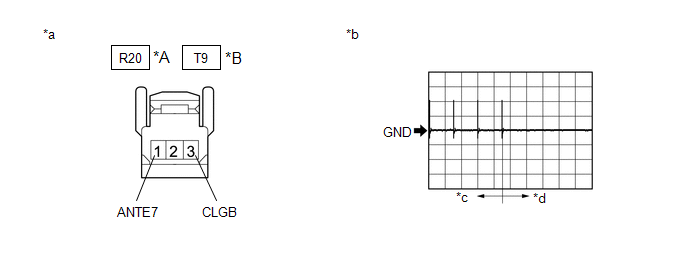
| *A | w/o Rear No. 2 Seat | *B | w/ Rear No. 2 Seat |
| *a | Front view of wire harness connector (to No. 3 Indoor Electrical Key Antenna Assembly (Inside Luggage Compartment)) | *b | Waveform 1 |
| *c | For 30 seconds after closing any door | *d | After 30 seconds or more have elapsed since any door closed |
OK:
| Tester Connection | Condition | Tool Setting | Specified Condition |
|---|---|---|---|
| R20-1 (ANTE7) - R20-3 (CLGB)*1 | Procedure:
| 2 V/DIV., 500 ms/DIV. | Pulse generation (See waveform 1) |
| T9-1 (ANTE7) - T9-3 (CLGB)*2 |
- *1: w/o Rear No. 2 Seat
- *2: w/ Rear No. 2 Seat
| NG | .gif) | REPLACE CERTIFICATION ECU (SMART KEY ECU ASSEMBLY) |
|
| 17. | REPLACE NO. 3 INDOOR ELECTRICAL KEY ANTENNA ASSEMBLY (INSIDE LUGGAGE COMPARTMENT) |
(a) Temporarily replace the No. 3 indoor electrical key antenna assembly (inside luggage compartment) with a new one.
w/o Rear No. 2 Seat: Click here .gif)
w/ Rear No. 2 Seat: Click here .gif)
|
| 18. | CHECK POWER SOURCE MODE |
(a) Get into the vehicle while carrying an electrical key transmitter sub-assembly.
(b) Move the shift lever to P.
(c) Press the engine switch with the brake pedal released and check that the power source mode changes.
| Result | Proceed to |
|---|---|
| The power source mode changes | A |
| The power source mode does not change | B |
| A | .gif) | END (NO. 3 INDOOR ELECTRICAL KEY ANTENNA ASSEMBLY (INSIDE LUGGAGE COMPARTMENT) WAS DEFECTIVE) |
| B | .gif) | REPLACE CERTIFICATION ECU (SMART KEY ECU ASSEMBLY) |
| 19. | READ VALUE USING TECHSTREAM (START SWITCH1, START SWITCH2) |
(a) Connect the Techstream to the DLC3.
(b) Turn the engine switch on (IG).
(c) Turn the Techstream on.
(d) Enter the following menus: Body Electrical / Power Source Control / Data List.
(e) Read the Data List according to the display on the Techstream.
Body Electrical > Power Source Control > Data List| Tester Display | Measurement Item | Range | Normal Condition | Diagnostic Note |
|---|---|---|---|---|
| Start Switch1 | Engine switch 1 status | OFF or ON | OFF: Engine switch not pressed ON: Engine switch pressed |
|
| Start Switch2 | Engine switch 2 status | OFF or ON | OFF: Engine switch not pressed ON: Engine switch pressed |
|
| Tester Display |
|---|
| Start Switch1 |
| Start Switch2 |
OK:
The Techstream display changes correctly in response to the engine switch operation.
| OK | .gif) | USE SIMULATION METHOD TO CHECK |
|
| 20. | INSPECT ENGINE SWITCH |
(a) Remove the engine switch.
Click here .gif)
(b) Inspect the engine switch.
Click here .gif)
| NG | .gif) | REPLACE ENGINE SWITCH |
|
| 21. | CHECK HARNESS AND CONNECTOR (CERTIFICATION ECU (SMART KEY ECU ASSEMBLY) - ENGINE SWITCH) |
(a) Disconnect the J41 certification ECU (smart key ECU assembly) connector.
(b) Measure the resistance according to the value(s) in the table below.
Standard Resistance:
| Tester Connection | Condition | Specified Condition |
|---|---|---|
| J41-23 (SSW1) - J14-5 (SS1) | Always | Below 1 Ω |
| J41-21 (SSW2) - J14-1 (SS2) | Always | Below 1 Ω |
| J41-11 (AGND) - J14-6 (AGND) | Always | Below 1 Ω |
| J41-23 (SSW1) or J14-5 (SS1) - Body ground | Always | 10 kΩ or higher |
| J41-21 (SSW2) or J14-1 (SS2) - Body ground | Always | 10 kΩ or higher |
| J41-11 (AGND) or J14-6 (AGND) - Body ground | Always | 10 kΩ or higher |
| OK | .gif) | REPLACE CERTIFICATION ECU (SMART KEY ECU ASSEMBLY) |
| NG | .gif) | REPAIR OR REPLACE HARNESS OR CONNECTOR |
| 22. | CHECK KEY DIAGNOSTIC MODE |
(a) Check the following antennas in key diagnostic mode.
Body Electrical > Smart Access > Utility| Tester Display |
|---|
| Communication Check(Key Diag Mode) |
HINT:
- Select either channel 1 or channel 2 and perform the key diagnostic mode inspection for each channel.
- If the buzzer sounds with [CH1] displayed but not with [CH2], the electrical key transmitter sub-assembly cannot be detected by channel 2 due to a malfunction, such as wave interference.
- It is possible to check if the transponder key amplifier built into the engine switch is operating by the sounding of the buzzer.
| (b) Check the engine switch. Face the logo side of the electrical key transmitter sub-assembly toward the engine switch, hold the electrical key transmitter sub-assembly near the engine switch and check that the wireless buzzer sounds. |
|
| Result | Proceed to |
|---|---|
| The wireless buzzer does not sound | A |
| The wireless buzzer sounds | B |
| B | .gif) | REPLACE ENGINE SWITCH |
|
| 23. | CHECK FOR DTC |
(a) Using the Techstream, check for certification ECU (smart key ECU assembly) DTCs.
Body Electrical > Power Source Control > Trouble Codes Body Electrical > Smart Access > Trouble Codes| Result | Proceed to |
|---|---|
| DTCs are not output | A |
| Smart access system with push-button start (for Start Function) DTCs are output | B |
| B | .gif) | GO TO DIAGNOSTIC TROUBLE CODE CHART |
|
| 24. | CHECK HARNESS AND CONNECTOR (POWER SOURCE) |
Click here .gif)
| NG | .gif) | REPAIR OR REPLACE HARNESS OR CONNECTOR IN CIRCUIT CONNECTED TO POWER SOURCE |
|
| 25. | CHECK HARNESS AND CONNECTOR (GROUND) |
Click here .gif)
| NG | .gif) | REPAIR OR REPLACE HARNESS OR CONNECTOR |
|
| 26. | CHECK HARNESS AND CONNECTOR (CERTIFICATION ECU (SMART KEY ECU ASSEMBLY) - INSTRUMENT PANEL JUNCTION BLOCK ASSEMBLY) |
(a) Disconnect the 2A and 2B instrument panel junction block assembly connectors.
(b) Measure the resistance according to the value(s) in the table below.
Standard Resistance:
| Tester Connection | Condition | Specified Condition |
|---|---|---|
| J41-16 (ACCD) - 2A-30 | Always | Below 1 Ω |
| J41-17 (IG1D) - 2A-17 | Always | Below 1 Ω |
| 2B-3 - Body ground | Always | Below 1 Ω |
| J41-16 (ACCD) or 2A-30 - Body ground | Always | 10 kΩ or higher |
| J41-17 (IG1D) or 2A-17 - Body ground | Always | 10 kΩ or higher |
| NG | .gif) | REPAIR OR REPLACE HARNESS OR CONNECTOR |
|
| 27. | CHECK INSTRUMENT PANEL JUNCTION BLOCK ASSEMBLY (IG1 NO. 1, IG1 NO. 2, IG1 NO. 3, ACC RELAY) |
(a) Remove the instrument panel junction block assembly.
Click here .gif)
.gif)
(b) Measure the resistance according to the value(s) in the table below.
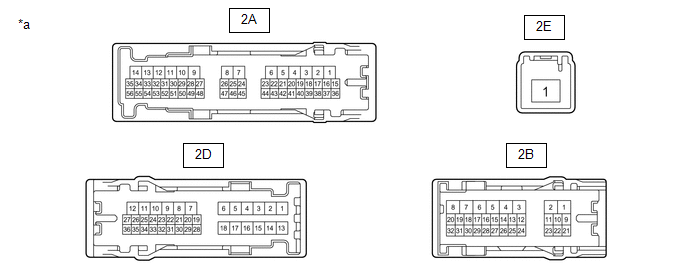
| *a | Component without harness connected (Instrument Panel Junction Block Assembly) | - | - |
Standard Resistance:
| Tester Connection | Condition | Specified Condition |
|---|---|---|
| 2A-30 - 2B-3 | 20°C (68°F) | 285.71 to 428.57 Ω |
| 2A-17 - 2B-3 | 20°C (68°F) | 142.86 to 214.29 Ω |
| 2E-1 - 2A-40 | Battery voltage applied between terminals 2A-30 and 2B-3 | Below 1 Ω |
| Battery voltage not applied between terminals 2A-30 and 2B-3 | 10 kΩ or higher | |
| 2E-1 - 2A-35 | Battery voltage applied between terminals 2A-17 and 2B-3 | Below 1 Ω |
| Battery voltage not applied between terminals 2A-17 and 2B-3 | 10 kΩ or higher | |
| 2E-1 - 2D-12 | Battery voltage applied between terminals 2A-17 and 2B-3 | Below 1 Ω |
| Battery voltage not applied between terminals 2A-17 and 2B-3 | 10 kΩ or higher |
| NG | .gif) | REPLACE INSTRUMENT PANEL JUNCTION BLOCK ASSEMBLY |
|
| 28. | CHECK CERTIFICATION ECU (SMART KEY ECU ASSEMBLY) |
(a) Install the instrument panel junction block assembly.
Click here .gif)
(b) Reconnect the J41 certification ECU (smart key ECU assembly) connector.
(c) Measure the voltage while confirming the power source mode on the Data List.
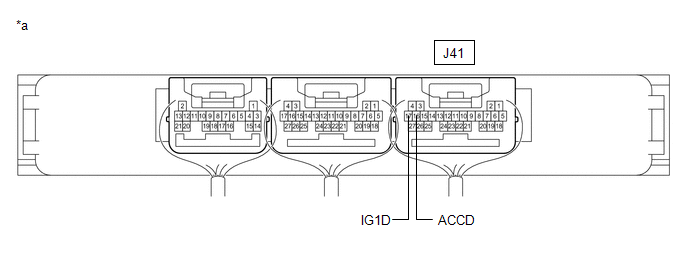
| *a | Component with harness connected (Certification ECU (Smart Key ECU Assembly)) | - | - |
| Tester Display | Measurement Item | Range | Normal Condition | Diagnostic Note |
|---|---|---|---|---|
| Power Supply Condition | Power supply state | All OFF, ACC ON, IG ON or ST ON | All OFF: Engine switch off ACC ON: Engine switch on (ACC) IG ON: Engine switch on (IG) ST ON: Sending engine start request signal | - |
| Tester Display |
|---|
| Power Supply Condition |
Standard Voltage:
| Tester Connection | Condition | Specified Condition |
|---|---|---|
| J41-17 (IG1D) - Body ground | Engine switch off | 1 V or less |
| Engine switch on (ACC) | 1 V or less | |
| Engine switch on (IG) | 9 V or higher | |
| J41-16 (ACCD) - Body ground | Engine switch off | 1 V or less |
| Engine switch on (ACC) | 8.5 V or higher | |
| Engine switch on (IG) | 8.5 V or higher |
| OK | .gif) | USE SIMULATION METHOD TO CHECK |
| NG | .gif) | REPLACE CERTIFICATION ECU (SMART KEY ECU ASSEMBLY) |
| 29. | INSPECT TRANSMITTER BATTERY |
(a) Inspect the transmitter battery.
Click here .gif)
NOTICE:
Do not wrap the lead wire ground a terminal, wedge it between terminals, or solder it. The terminal may be deformed or damaged, and the transmitter battery will not be able to be installed correctly.
| OK | .gif) | REPLACE ELECTRICAL KEY TRANSMITTER SUB-ASSEMBLY |
| NG | .gif) | REPLACE TRANSMITTER BATTERY |
 Engine does not Start
Engine does not Start
DESCRIPTION When the electrical key transmitter sub-assembly is in the cabin and the engine switch is pressed, the certification ECU (smart key ECU assembly) receives a signal and changes the power so ...
 Power Source Mode does not Change to ON (IG)
Power Source Mode does not Change to ON (IG)
DESCRIPTION If the engine switch is pressed with the electrical key transmitter sub-assembly in the cabin, the certification ECU (smart key ECU assembly) receives a signal and changes the power source ...
Other materials:
Lexus RX (RX 350L, RX450h) 2016-2025 Repair Manual > Lin Communication System: Lost Communication with Power Source Control (B278C)
DESCRIPTION This DTC is stored when LIN communication between the certification ECU (smart key ECU assembly) and power management control ECU stops for 10 seconds or more. DTC No. Detection Item DTC Detection Condition Trouble Area B278C Lost Communication with Power Source Control ...
Lexus RX (RX 350L, RX450h) 2016-2025 Repair Manual > Audio And Visual System (for 8 Inch Display): Registered Device cannot be Deleted
PROCEDURE 1. DELETE OPERATION (a) Check if a registered portable player can be deleted normally. OK: Registered portable player can be deleted normally. OK END NG PROCEED TO NEXT SUSPECTED AREA SHOWN IN PROBLEM SYMPTOMS TABLE ...
Lexus RX (RX 350L, RX450h) 2016-{YEAR} Owners Manual
- For your information
- Pictorial index
- For safety and security
- Instrument cluster
- Operation of each component
- Driving
- Lexus Display Audio system
- Interior features
- Maintenance and care
- When trouble arises
- Vehicle specifications
- For owners
Lexus RX (RX 350L, RX450h) 2016-{YEAR} Repair Manual
0.0156

.gif)
